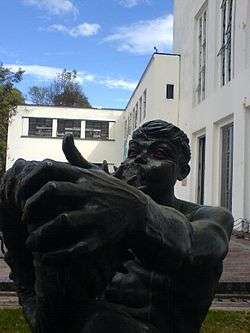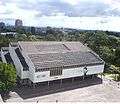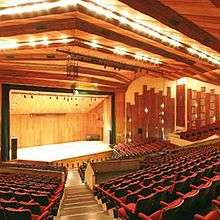National University of Colombia
| Universidad Nacional de Colombia | |
 | |
| Motto | Inter-Aulas-Academiæ-Quære-Verum |
|---|---|
Motto in English | Search for the truth among the rooms of the academy |
| Type | Public, National |
| Established | September 22, 1867 |
| Rector | Ignacio Mantilla Prada |
Administrative staff | 2,862 |
| Students | 44,939 |
| Undergraduates | 38,256 |
| Postgraduates | 6,283 |
| 423[1] | |
| Location |
Bogotá, D.C., Cundinamarca, Colombia 4°38′8″N 74°4′58″W / 4.63556°N 74.08278°WCoordinates: 4°38′8″N 74°4′58″W / 4.63556°N 74.08278°W |
| Campus | 300 acres (1,214,056.9 m2), Urban |
| Colours | Green and White |
| Website |
www |
 | |
The Universidad Nacional de Colombia (English: National University of Colombia), is a public, national, coeducational, research university, located primarily in Bogotá, Medellín, Manizales and Palmira, Colombia. Established in 1867 by an act of the Congress of Colombia,[2] the university is the largest higher education institution of the country with more than 44,000 students, the largest number of graduated professionals per year, and number of academic programmes at undergraduate and graduate levels, with 430 academic programmes, which includes 96 graduate diplomas, 67 Academic specializations, 39 medical specialties, 161 Master's degrees, and 58 doctorates. It is also one of the few universities that employs post-doctorate fellows in the country. Approximately 40,000 students are studying for an undergraduate degree and 4,000 for a graduate degree. The National University of Colombia is widely known as the best Colombian university, and one of the best universities in Latin america, for its high degree of education and research achievement in several rankings of universities in Latin America and around the globe.[3]
The university is a member of the Association of Colombian Universities (ASCUN),[4] the Iberoamerican Association of Postgraduate Universities (AUIP),[5] and the Iberoamerican University Network Universia. Along with Antioquia and Valle universities, it conforms what is known as the Golden Triangle of higher education in Colombia,[6] being among the most selective and competitive universities in the country. A study by SCImago Research Group found it to be the Colombian university producing the largest number of scientific papers published in peer-refereed publications, and the 17th most prolific in Latin America.[7] Furthermore, according to the Latinamerican Web Ranking of Universities, the National University of Colombia ranked in the first place of the country in internet presence, and among the first universities in the region.[8] Regarding the CIVETS universities, the National University occupied the second place.[9]
The institution offers a wide selection of programmes in both undergraduate and graduate levels, such as medicine, nursing, dentistry, engineering, chemistry, pharmacy, mathematics, physics, geology, biology, psychology, social sciences, arts (music, fine arts), languages, philosophy, and law.
Campus
Bogota Branch
The University City of Bogotá (Spanish: Ciudad Universitaria de Bogotá), also known as the White City (Spanish: Ciudad Blanca), is the main University campus. It is located in the Teusaquillo locality, northwest of the historical centre. It is also the largest campus in Colombia, with an extension of 1,200,000 m2 (300 acres) and a constructed area of 308,541 m2 (76.242 acres), making it an ample campus with several green areas, open spaces, and pedestrian paths. Among its buildings there are 17 which have been declared national monuments and, as a whole, it is a representation of the last 60 years of architecture in Colombia.
The campus was designed by German educationalist Fritz Karsen and architect Leopold Rother, both refugees from Nazi Germany. The construction began in 1935, under the government of Alfonso López Pumarejo. It is organized as an ellipse, divided in five parts, each containing one of the academic divisions and its respective dependencies. From Aerial view it can see the shape of an owl that is emblematic of a deep connection with wisdom and intuitive knowledge. The buildings were constructed as prismatic blocks, and painted white, in order to give an austere and clean look.
Some landmarks in the campus are the León de Greiff Auditorium, and the Francisco de Paula Santander Plaza, also known unofficially as the "Central Plaza" or the "Ché Plaza", in honor of Ernesto el Ché Guevara. The campus has its own stadium, where sometimes matches for the Colombian Professional Football are held.
Medellín Branch
The National University of Colombia, Medellín has two campuses, which are the Central Campus and Campus Robledo, where 10,447 students study. This site provides approximately 29% of the seats for new students at National. Also this site has 555 faculty professors, of which 38% are doctors, 44% are master's, 8% were specialists and 10% are Professionals. This site offers 26 undergraduate and 73 graduate and categorized : 15 PhDs, 28 Masters and 29 specializations.
Its history has given Medellín a peculiar character, since it was formed as most of their universities from the classic degrees of Law, Medicine, Arts and Sciences. The site grew out of engineering programs, which is why today, the Medellín has the highest number of engineering (17) of the National University of Colombia and Colombia in general, being so, from the past, leading in the development, teaching and application of engineering in Colombia.
Central Campus: Located northwest of downtown, between Cerro Ecoparque the Flyer and the Medellín River. It is since 1938 the headquarters of the National University of Colombia in Medellin when the School of Tropical Agriculture (now the Faculty of Agricultural Sciences) joined the University. The Central Campus is made up of the Nucleus The Rocket which has a 272,982 m² area, the heart of Rio that has an area of 31,758 m² and a portion of Cerro El Flying around 269,257 m² that belongs to the Universidad.14 is highlights the Entomological Museum founded in 1937, the Museum of Mycology founded in 1987, the Herbarium "Gabriel Gutierrez," the wood collection, the Central Library "Efe Gomez" as attractive artistic and architectural highlights, the Totem Mythic created by Master Pedro Nel Gomez, Block 41 declared a National Cultural, designed by Engineer Jesús Montoya Mejía which began in 1931, the Block 11 Master designed by Pedro Nel Gómez.
Campus Robledo Robledo Also called core or more colloquially as the School of Mines, is located northwest of the city of Medellin, Robledo neighborhood is composed of three fields separated by Kr 80, which presents a difficult high traffic pedestrian connection between the properties that make up the physical structure of the School of Mines, and Ingeominas, recently integrated into the University. It has an area of 100,978.69 m² .14 In 1886, the School of Mines was created and it was joined to the University in 1936, today is the National School of Mines and has approximately 3,500 students. It highlights the Museum of Geosciences, Maximum classroom buildings (block M5) and M3 block designed by Master Pedro Nel Gomez School of Mines in 1936. Declared National Monument in 1994 thanks to its architecture and its murals by the same Pedro Nel Gómez. The University in Medellin has 5 faculties of the schools offer 25 careers, nearly half of them are engineering at the School of Mines, also has three museums and other services.
Academics

The National University of Colombia has 20 schools distributed among Bogotá, Medellín, Manizales and Palmira:
Departments in Bogotá:
- Agricultural Sciences
- Dentistry
- Economics Sciences
- Engineering
- Fine Arts
- Human Sciences
- Law, Social and Political Sciences
- Medicine
- Nursing Faculty
- Science
- Veterinary Medicine and Animal Management
Interfaculty institutes[10]
- Institute of Biotechnology
- Institute of Science and Food Technology - ICTA
- Institute of Environmental Studies - IDEA-
- Institute of Studies in Communication - IECO-
- International institute of Political Studies and Relations - IEPRI-
- Genetics Institute
Museums in Bogotá Campus:
- Casa Museo Jorge Eliécer Gaitán (Jorge Eliecer Gaitan Museum)
- Museo de Arte Universidad Nacional de Colombia (National University's Art Museum)
- Museo de Arquitectura Leopoldo Rother (Leopoldo Rother Museum of Architecture)
- Museo de Historia Natural (Museum of Natural History)
- Museo de la Ciencia y el Juego (Museum of Science and Games)
- Museo Centro de Historia de la Medicina (Museum Centre of the History of Medicine)
- Museo Entomológico (Entomological Museum)
- Observatorio Astronómico Nacional (National Astronomical Observatory)
High school (for children of professors, students, and employees):
- "Arturo Ramírez Montúfar" Pedagogical Institute - IPARM-
Departments in Medellín:
- Sciences
- Agricultural Sciences
- Mines
- Economics and Humans Sciences
- Arquitecture
Museums in Medellín Campus:
- Earth Sciences Museum
- Entomological Museum
- Mycology museum
- "Gabriel Gutiérrez"Herbarium
- Xiloteca
Institutes:
- Centre for Research in Extractive Metallurgy - CIMEX
- Energy Institute
- Institute for Systems and Decision Sciences
- System Institute
- Institute of Materials
- Water Institute
- Fuel Centre
- Institute of Environmental Studies - IDEA
Media:
- Unimedios
- News agency (Agencia de Noticias UN)
- Internal newspaper (Carta Universitaria)
- Radio station (UN Radio)
- Academic newspaper (UN Periódico, with articles ranging from international issues to research within the colleges)
- UN Televisión (TV production company)
- Prisma TV (internet television)
Noted people
List of rectors
- 1990-1993, Antanas Mockus Sivickas
- 1994-1997, Guillermo Páramo Rocha
- 1997-2003, Víctor Manuel Moncayo Cruz
- 2003-2005, Marco Antonio Palacios Rozo
- 2005-2006, Ramón Fayad Nafah
- 2006–2012, Moisés Wasserman Lérner
- 2012–present, Ignacio Mantilla Prada
Notable alumni
Famous personalities among its alumni include:
- Fernando Botero
- Jorge Eliécer Gaitán
- Fernando Vallejo
- Gabriel García Márquez
- Carlos Jacanamijoy
- Hernando Osorio
- Manuel Elkin Patarroyo
- Rodrigo Bernal
- José Félix Patiño
- Julio Garavito Armero
- León de Greiff
- Leopold Rother
- Totó la Momposina
- Rogelio Salmona
- Salomón Hakim
- Antanas Mockus
- Jaime Garzón
- Luis Carlos Sarmiento Angulo
- José Eustasio Rivera
- Zuleika Suarez
- Luis Villar Borda
Gallery
School of Economics 
Chemistry Department 
College of Medicine 
Pharmacy Department Sculpture Park 
Agustín Codazzi Geographic Institute Ernesto Guhl Library Alfonso López Pumarejo Stadium 
School of Engineering 
Fine Arts 
Sociology 
School of Agronomy 
Library of Science and Technology 
Central Library
(“Biblioteca Gabriel García Márquez”)Central Library (lobby view) Genetics Institute 
Sports Complex 
León de Greiff Auditorium
See also
Notes
- ↑ Unidad de Medios de Comunicación, Unimedios (May 2007). "Posgrados en Colombia" (PDF). Claves para el debate público (in Spanish) (1). ISSN 1909-9096. Retrieved October 8, 2007.
- ↑ "Universidad Nacional de Colombia - Reseña histórica" (in Spanish). Retrieved 2008-01-13.
- ↑ "SIR Iber 2015 Rank: Output" (PDF). scimagoir.com. Retrieved 6 August 2016.
- ↑ "Universidades Afiliadas". Archived from the original on November 22, 2008. Retrieved 2009-02-22.
- ↑ "Instituciones Asociadas a la AUIP". Retrieved 2009-02-22.
- ↑ Ordóñez Burbano, Luis A. (2007). Universidad del Valle 60 años 1945-2005: Atando cabos en clave de memoria. Cali, Valle del Cauca, Colombia: Universidad del Valle. p. 58. ISBN 978958-44-1844-9.
- ↑ "Ranking SCImago Iberoamérica 2015" (PDF). SCImago. Retrieved 19 May 2016.
- ↑ "Latinamerican Ranking Web". webometrics (in Spanish). Retrieved 2012-11-25.
- ↑ "QS World University Rankings® 2016/17.". topuniversities.com. Retrieved 6 August 2016.
- ↑ "Institutos y Centros de la UN". Unal.edu.co. Retrieved 2012-06-04.
References
- Oficina Nacional de Planeación (September 2006). "Estadísticas e Indicadores de la Universidad Nacional de Colombia 2005" (PDF). Estadísticas e Indicadores de la Universidad Nacional de Colombia (in Spanish) (11). ISSN 0123-8566. Retrieved March 11, 2007.
External links
| Wikimedia Commons has media related to National University of Colombia. |
- National University of Colombia Main Page
- National University of Colombia OCW
- National Direction of Cultural Divulgation
- National University Museum of Art
- Leopoldo Rother Museum of Architecture